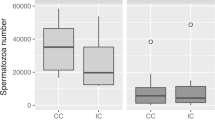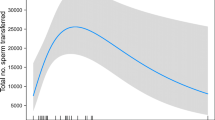Abstract
Female St Andrew’s Cross spiders control copulation duration by timing sexual cannibalism and may thereby control paternity if cannibalism affects sperm transfer. We have investigated the effect of copulation duration on sperm transfer and documented sperm storage patterns when we experimentally reduced the ability of females to attack and cannibalise the male. Virgin males and females were paired and randomly allocated either to a control treatment, where females were allowed to attack and cannibalise the male during copulation, or to an experimental treatment, where females were unable to cannibalise the male. The latter was achieved by placing a paintbrush against her chelicerae during copulation. Our experimental manipulation did not affect copulation duration or sperm storage. However, the number of sperm stored by the female increased with copulation duration only if the male was cannibalised, suggesting that cannibalism increases relative paternity not only through prolonged copulation duration following a fair raffle model but also through the cannibalism act itself. Future studies should explore whether cannibalised males ejaculate more sperm or whether females selectively store the sperm of cannibalised males.

Similar content being viewed by others
References
Andrade MCB (1996) Sexual selection for male sacrifice in the Australian red back spider. Science 271:70–72
Austad SN (1982) First male sperm priority in the bowl and doily spider, Frontinella pyramitela (Walckenaer). Evolution 36:777–785
Bukowski TC, Christenson TE (1997) Determinants of sperm release and storage in a spiny orbweaving spider. Anim Behav 53:381–395
Bukowski TC, Linn CD, Christenson TE (2001) Copulation and sperm release in Gasteracantha cancriformis (Araneae: Araneidae): differential male behaviour based on female mating history. Anim Behav 62:887–895
Burger M (2007) Sperm dumping in a haplogyne spider. J Zool 273:74–81
Eberhard WG (1996) Female control: sexual selection by cryptic female choice. Princeton University Press, Princeton
Eberhard W (2004) Why study spider sex: special traits of spiders facilitate studies of sperm competition and cryptic female choice. J Arachnol 32:545–556
Elgar MA (1992) Sexual cannibalism in spiders and other invertebrates. In: Elgar MA, Crespi BJ (eds) Cannibalism. Ecology and evolution among diverse taxa. Oxford University Press, Oxford
Elgar MA (1998) Sperm competition and sexual selection in spiders and other arachnids. In: Birkhead TR, Moller AP (eds) Sperm competition and sexual selection. Academic, London, pp 307–339
Elgar MA, Schneider JM (2004) Evolutionary significance of sexual cannibalism. Adv Stud Behav 34:135–163
Elgar MA, Schneider JM, Herberstein ME (2000) Female control of paternity in the sexually cannibalistic spider Argiope keyserlingi. Proc R Soc B 267:2439–2443
Faraway JJ (2005) Linear Models with R. Chapman and Hall/CRC, Boca Raton, FL
Foellmer MW, Fairbairn DJ (2003) Spontaneous male death during copulation in an orb-weaving spider. Proc R Soc B 270:S183–S185
Foellmer MW, Fairbairn DJ (2004) Males under attack: sexual cannibalism and its consequences for male morphology and behaviour in an orb-weaving spider. Evol Ecol Res 6:163–181
Fromhage L, Uhl G, Schneider JM (2003) Fitness consequences of sexual cannibalism in female Argiope bruennichi. Behav Ecol Sociobiol 55:60–64
Gaskett AC, Herberstein ME, Downes BJ, Elgar MA (2004) Life-time male mating preferences in a sexually cannibalistic orb-web spider (Araneae: Araneidae). Behaviour 141:1197–1210
Herberstein ME, Schneider JM, Elgar MA (2002) Costs of courtship and mating in a sexually cannibalistic orb-web spider: female mating strategies and their consequences for males. Behav Ecol Sociobiol 51:440–446
Herberstein ME, Barry KL, Turoczy MA, Wills E, Youssef C, Elgar MA (2005a) Post-copulation mate guarding in the sexually cannibalistic St Andrew’s Cross spider (Araneae Araneidae). Ethol Ecol Evol 17:17–26
Herberstein ME, Gaskett AC, Schneider JM, Vella NGF, Elgar MA (2005b) Limits to male copulation frequency: sexual cannibalism and sterility in St Andrew’s cross spiders (Araneae, Araneidae). Ethology 111:1050–1061
Huber BA (2005) Sexual selection research on spiders: progress and biases. Biol Rev 80:363–385
Jones TM, Elgar MA (2008) Male insemination decisions and sperm quality influence paternity in the golden orb-weaving spider. Behav Ecol 19:285–291
Levi HW (1983) The orb-weaver Genera Argiope, Gea, and Neogea from the western Pacific region (Araneae: Araneidae, Argiopinae). Bull Mus Comp Zool 150:247–338
Linn CD, Molina Y, Difatta J, Christenson TE (2007) The adaptive advantage of prolonged mating: a test of alternative hypotheses. Anim Behav 74:481–485
Parker GA (1984) Sperm competition and the evolution of animal mating strategies. In: Smith RL (ed) Sperm competition and the evolution of animal mating systems. Academic, Orlando, pp 1–60
Parker GA, Simmons LW (1991) A model of constant random sperm displacement during mating: evidence from Scatophaga. Proc R Soc B 246:107–115
Prenter J, Elwood RW (2006) Sexual cannibalism and mate choice. Anim Behav 71:481–490
R Development Core Team (2009) R: a language and environment for statistical computing. R Foundation for Statistical Computing, Vienna. Available at: http://www.R-project.org
Sasaki T, Iwahashi O (1995) Sexual cannibalism in an orb-weaving spider Argiope aemula. Anim Behav 49:1119–1121
Schaefer MA, Uhl G (2002) Determinants of paternity success in the spider Pholcus phalangioides (Pholcidae: Araneae): the role of male and female mating behaviour. Behav Ecol Sociobiol 51:368–377
Schneider JM, Elgar MA (2001) Sexual cannibalism and sperm competition in the golden orb-web spider Nephila plumipes (Araneoidea): female and male perspectives. Behav Ecol 12:547–552
Schneider JM, Lesmono K (2009) Courtship raises male fertilization success through post-mating sexual selection in a spider. Proc R Soc B 276:3105–3111
Schneider JM, Gilberg S, Fromhage L, Uhl G (2006) Sexual conflict over copulation duration in a cannibalistic spider. Anim Behav 71:781–788
Schoefl G, Taborsky M (2002) Prolonged tandem formation in firebugs (Pyrrhocris apterus) serves mate-guarding. Behav Ecol Sociobiol 52:426–433
Simmons LW (2001) Sperm competition and its evolutionary consequences in the insects. Princeton University Press, Princeton
Snow LSE, Andrade MCB (2004) Pattern of sperm transfer in redback spiders: implications for sperm competition and male sacrifice. Behav Ecol 15:785–792
Stoltz JA, Andrade MCB (2009) Female’s courtship threshold allows intruding males to mate with reduced effort. Proc R Soc B 277:585–592
Sziranyi A, Kiss B, Samu F, Harand W (2005) The function of long copulation in the wolf spider Pardosa agrestis (Araneae, Lycosidae) investigated in a controlled copulation duration experiment. J Arachnol 33:408–414
Wilder SM, Rypstra AL, Elgar MA (2009) The importance of ecological and phylogenetic conditions for the occurrence and frequency of sexual cannibalism. Ann Rev Ecol Evol Syst 40:21–39
Acknowledgments
We thank Garine Assadourian for help with the spider collection and maintenance, the Australian Research Council (DP0662873 to MEH) for financial support and two anonymous reviewers for helpful suggestions. SP was supported by the grant no. MSM0021622416 provided by the Ministry of Education, Youth and Sports of the Czech Republic.
Author information
Authors and Affiliations
Corresponding author
About this article
Cite this article
Herberstein, M.E., Schneider, J.M., Harmer, A.M.T. et al. Sperm storage and copulation duration in a sexually cannibalistic spider. J Ethol 29, 9–15 (2011). https://doi.org/10.1007/s10164-010-0213-5
Received:
Accepted:
Published:
Issue Date:
DOI: https://doi.org/10.1007/s10164-010-0213-5




